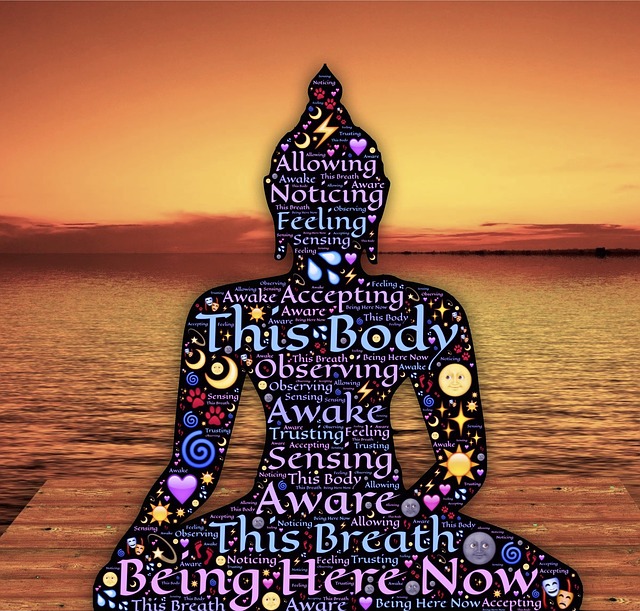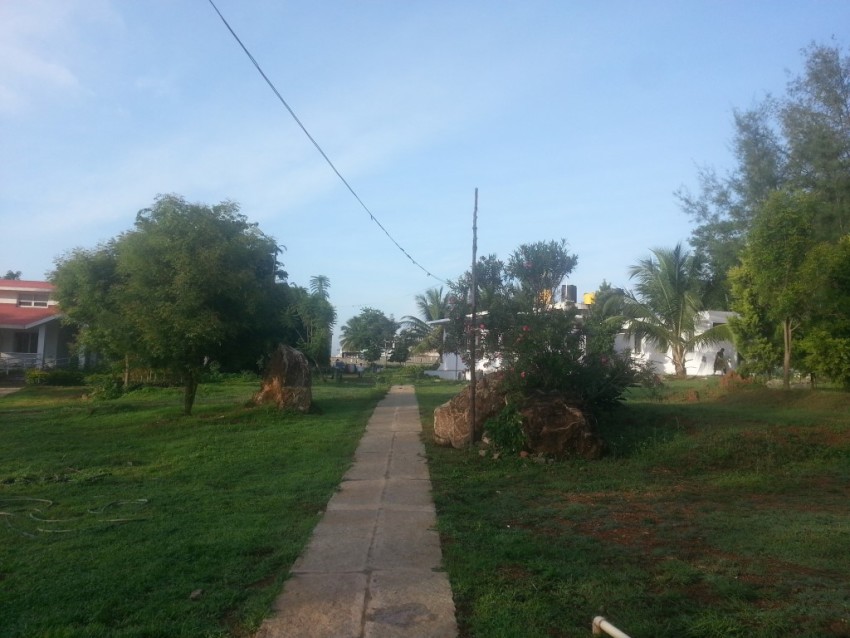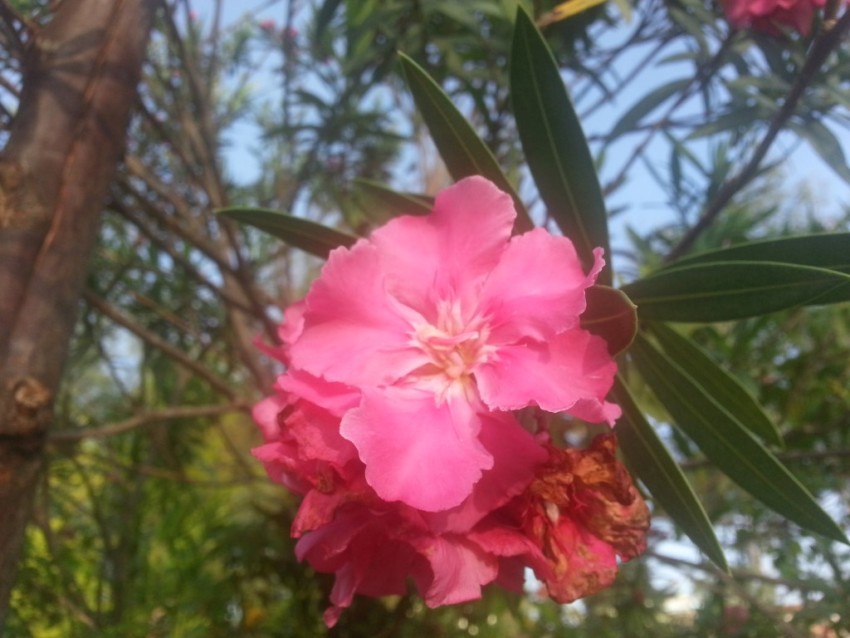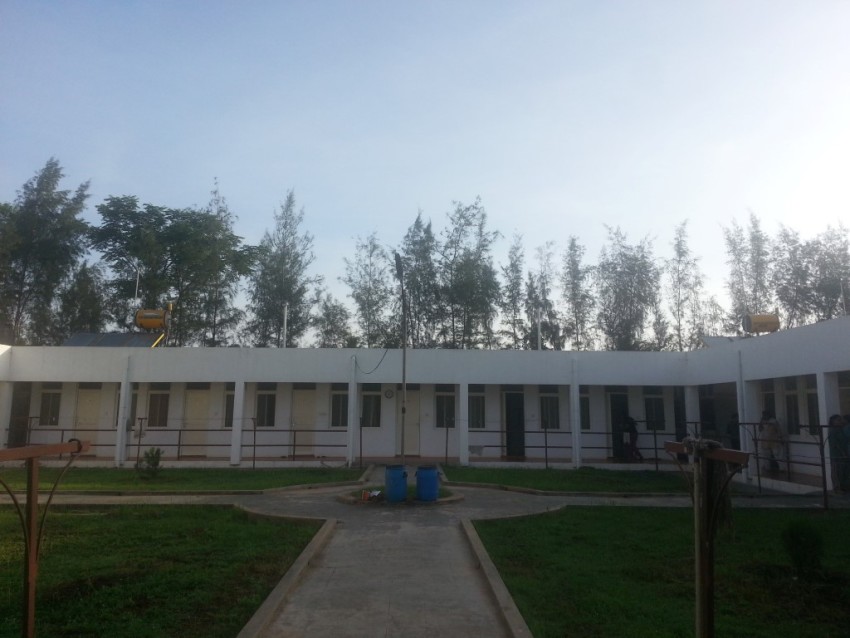
I am sitting cross-legged in a fairly large meditation hall, my knees resting awkwardly on two pillows. I am propped up on two other pillows. Outside, I hear birds and a grass-cutting machine hypnotically whirring its way through. Inside the hall, someone coughs. I hear the person next to me deeply sigh. I bend over, doubled in agony as shooting pains pass through my weak left knee. My right knee is numb, a heavy dead weight I can’t seem to ignore no matter what I tell my mind. My back is spasming, and I can feel a thin trickle of sweat run down it. I am in pain. Excruciating, nerve-jangling pain. And…I am supposed to be meditating.
My reasons for doing the 10-day Vipassana course as taught by S.N Goenka were many. I would not go into them in much detail here as I already covered them in my blog post “My Trysts With Meditation.” Singularly, my focus this year has been on finding myself, and meditation, even a grueling 10-day meditation boot camp, is just one way toward that path.
Did I find myself? How was the course? Should I do it? Many are the questions I have been asked and I will answer them later at the end of this post. For ease of access, I have divided this post into different sections. You may simply choose the sections that interest you the most.
Section 1 : The Beginning
Section 2 : The Daily Routine
Section 3 : The Meditation
Section 4 : The Philosophy
Section 5 : The Questions
The Beginning

Vipassana is marketed as a 10-day retreat. But in essence, it is 12 days. I started the course on June 1st, and was ‘released’ only on the 12th. All of these days are strictly regimented. On Day 0, you are asked to give your mobile phone, any electronic devices, intoxicants, and anything else for safekeeping. I kept with me not even a journal. I am a writer without any instrument except my mind for the next 10 days. On arrival, you are asked to fill in a form, which also curiously wants to know your designation and work status. Why? I wonder. The arrival process is rather chaotic, despite the best efforts of the volunteers there. You are assigned a room, seemingly arbitrarily, but not really. I am then asked to meet the Assistant Teacher who asks me if I am prepared to observe ‘Noble Silence.’ I nod. “You understand you can’t leave before the end of the course?” she asks. I nod again. And then I catch myself. I can still speak. And I can always speak to the meditation teacher. Noble Silence does not preclude that conversation, at least. I say yes.
In the evening, you get to talk to your roommate for a short period of time. This was quite important as being in the same room with another person AND not talk or maintain eye contact with that person is really torturous. Staying with a stranger is not new to me, as I have done my time in dorms. Ignoring that stranger for 10 days was new.
After a rather bizarre and hasty orientation, Noble Silence begins at 7:30PM, and the first meditation of the day begins. Nothing that I hadn’t been doing the past year. Just the practice of observing the breath as it comes in and as it goes out. Simple. And my life over the next 10 days would be distilled into this.
Wake up bell: 4:00 A.M.
I used to consider myself an early riser. But the 4AM bell was torturous. Much like a regimented school, one of the sevikas goes around ringing a little bell to make sure that you actually wake up and go to the meditation hall. Thinking of sleeping in? No chance.
Meditate in the hall: 4:30-6:30 A.M.
This was the worst time for me on all days. And this is what surprised me about myself. Would not a person who hates late nights be fresh at this time of the morning? Turns out no. I was easily distracted by the call of the birds. And there were many! The two hours that it stretches into are made even more excruciating because of the lack of silence outside, punctuated by the noisiness of those around you. Everyone had to sneeze, cough, belch, and burp at this hour!
Highlight: The Dhamma Phaphulla center is in the midst of nowhere, in the village of Alur. Walking groggily in the morning to the meditation hall, I would see the sky, pink with colors still while darkness still slept on the other side. That was to me a personal moment that resonated with much of how I view my own life.
Breakfast and shower: 6:30-8:00 A.M.
Breakfast would be simple South Indian fare. I hardly used to notice what I eat, focused as I was on just getting to the room to take bath, wash clothes, all before my roommate did. My roommate found a way of communicating what she wanted. She would leave a note on my bed saying that she has gone out for 20 minutes, and would be back, and in the meantime I can latch the door and take bath. Or that I should clean the room. I never reply to those notes. Why? Noble Silence means:
- A period of deep silence
- No body contact
- No eye contact
- No gestures or communication in any form with your fellow meditators
You are also strictly segregated and asked to observe other noble precepts such as no intoxicants, no lying, no stealing, and not harming any other being.
The silence here is considered essential for deep transformation. I believe it helps.
Group meditation in the hall: 8:00-9:00 A.M.
For the first three days, this was fairly benign. Only on the fourth day, when you are actually taught the Vipassana technique do you realize this group meditation is different from the rest because it means sitting for an hour with no change in posture. Nary a twiggle in your foot!
Meditate in the hall: 9:00-11:00 A.M.
Lunch and rest or discussion with your teacher: 11:00 A.M.-1:00 P.M.
Lunch was again fairly spartan meals. Nothing deep-fried. I would be so fatigued that all I cared for was to reach the room as soon as I can so that I can sleep. You are allowed only six hours of sleep during this period, and you end up trying to catch up wherever you can.
Meditate in the hall: 1:00-2:30 P.M.
When I look at this schedule, I think it’s crazy. And it is. Meditate for four hours? You are allowed to leave the hall whenever you want to stretch your legs, except during the killer Group Meditation sessions. However, strangely, these would turn out to be the best sessions for me. The afternoon nap refreshes me, and I find it easier to meditate.
Group meditation in the hall: 2:30-3:30 P.M.
Meditate in the hall: 3:30-5:00 P.M.
The Assistant Teachers also use this period to call the meditators or students as we are called in groups to answer any questions they may have about meditation. You are allowed to talk to the Assistant Teacher. Note that all teachings are conducted only by SN Goenka through recorded sessions. The Assistant Teachers play no part in the actual teaching of the technique.
Tea break: 5:00-6:00 P.M.
Your last meal of the day. And surprise! No dinner. You get a slice of fruit and tea or ragi malt. I became quite an addict of the ragi malt.
Highlight: Everyone would keep walking in a little path around the women’s residences during this time. I was reminded of prisoners of war in their zombified walk. I loved looking at all the little weeds and flowers and observing changes in them each day. You are not allowed to do yoga or exercise, but I didn’t miss my workouts. Ok, I did five push-ups one day when I was really sleepy.
Group meditation in the hall: 6:00-7:00 P.M.
Evening discourse: 7:00-8:15 P.M.
This is when you settle your weary mind and listen to Goenka talk, always with his silent wife next to him. I find him interesting, his discourses are often peppered with humor, and your wearied mind can scarce bring yourself to have intellectual argument for his discourse. You listen. You absorb. No arguments. Genius.
Final group meditation: 8:15-9:00 P.M.
No one really seemed to care about this last part of the day. You also have another window at 9PM to ask your teacher about any further questions.
Lights out: 9:30 P.M.
That above schedule looks daunting. And it is. There is nothing easy about Vipassana as taught by SN Goenka. I keep saying as taught by SN Goenka because it is important to understand that this is SN Goenka’s interpretation of Vipassana. I am not an expert on Buddhism, but I have always been a fan of the Buddha. He is the ultimate “cool guy,” as I once told my shocked colleagues. I admire the Buddha for not creating a dogmatic view of Heaven and Hell and mysterious Gods who deem it fit to reward or punish us.
The word “Vipassana” comes from a combination of “vi” (in various ways) and “passana,” (to see) which means to “see in various ways.” The technique is meant to cultivate deep insight, and at a very personal level, insight into yourself. There are many Vipassana techniques out there, many schools teaching it, and SN Goenka’s just happens to be one of the most popular and easily accessible ones. It’s not the right one, nor is it the wrong one. I wanted to use this period of time I granted myself to understand better my own mind, technique or no technique. And that’s all it was. top

On the first three days, you are taught to observe the breath with minor variations through to the fourth day. The key thing is to just observe the normal breath. No deep breathing. No chanting mantras in the head. Just observation. I find that my normal breath is quite choppy. Much like my mind. “Your breath is shallow, it is shallow. Your breath is deep, it is deep, “says Goenka. Just observe. So, I do. Where is the mind in the midst of all this? Mine runs frenzied circles. I did not come to the center in a peaceful state of mind. And it shows. I run to the past, grabbing scenes I didn’t know existed. I dream of futures, creating magical worlds where I am at peace. I turn back a 100 pains, and a 100 ecstasies. I am living my life. Again. All over again. And I am aware of how excruciatingly painful and beautiful it is. I don’t dig up childhood memories, but rather, the more recent ones.
“Every time your mind runs away, bring it back,” says the Assistant Teacher. Sometimes, I don’t want to make the effort to bring it back. I want to allow the mind its free run over the racecourse of my life. It seemed pleasant to sit and create daydreams. And almost a pleasure to dig through memories, even if bad. It didn’t matter if those were bad memories. You just remember. And you realize you love remembering. That this act of remembering is one you keep doing all your life. Remember remember remember. If the mind and memory were a sieve, would we really allow our past to sift through? No. We want to hold on to every little shred. But here I am. And I feel I am sifting through these. They pass through a sieve. For four days, I struggle. I am restless by nature. I can’t sit still for too long. And here I am, being forced to do just that. Pain.
You move through observation of the breath, to observation of the area around your nose, and then to observe any sensations that may arise on a narrower portion of your area – the area above the upper lip and the nostrils. This is supposed to concentrate your mind. I have used a key word here: sensations. The whole objective of Vipassana is to observe sensations. On Day 4, you extend this observation to the whole body. Through observing the changing nature of sensations on the body, you are taught to understand the essence of anicca or impermanence. This too shall pass. This is not mind-bending teaching or magical revelations. But when you are sense-deprived, sleep-deprived, everything becomes revelatory.
On the fourth day, you are also introduced to the “Sitting Meditation or Adithana.” Called the practice of determination, you do a repeated body scan and resist the urge to change posture. I change mine five times during the first session. And then, the second session, I grit my teeth. Nothing else taught more than these torturous sessions. I am determined to last it. I am competitive by nature, and losing to my mind was something I didn’t like. My knee throbs. My feet aches to be released from the pins pulsing through it. “Move your feet. Come on,” my mind hisses. It’s so easy. No one will shout at you if you do so. You are aware you are here entirely of your own volition. “Change,” my mind continues. I am not aware much any more of my thoughts. No dreary pasts intervene. All my attention is focused just on keeping still. I am sweating. I wait. Endlessly for the loudspeaker to come alive with the words anicca; with Goenka’s voice. And it does. I win. I feel exhilarated. The next day, I change posture just once. But after that, never again. Three times a day, I find myself sitting for an hour, scanning my body for sensations, unmoving. Each time it is tough. It never gets easy. Perhaps, it is not meant to.

The meditative technique is just that: observation of the breath. The philosophy underlying it comes from what Goenka says is the root cause of all misery: Our attachments or cravings and our aversions. We are always in search of something we want and we are always trying to remove what we don’t like. This constant pull and tug of war between two habitually opposed states is what makes our life miserable. Through observing the sensations, he reasons that we should understand the futility in attaching value to all that is merely ethereal and impermanent. Observe with equanimity.
Is it the philosophy of dissociation? Do you train your mind to become desensitized to all feelings? Would joy no longer arouse in you happiness? Would you not grieve if a friend passes away? I am not sure if Goenka addresses these kind of questions in detail, but I think it’s never explained clearly to new meditators. Equanimity does not mean a cool, detached or passive or indifferent attitude.
“Rather, it means an attitude of not interfering with the operation of the six senses. If you have a sensation in your knee and it’s painful and it wants to spread, you let it spread. Why? Because you discover that it is precisely the interference with that sensation that causes suffering, not the sensation itself. Equanimity literally means “balance.” It means not to push and pull the flow of the senses.”
– Source Shinzen.
I think the insight is not that pain causes suffering, but our resistance to it. It’s not a distinction apparent on the surface, but one that you truly gain as you meditate deeper.
The Questions
Should I do Vipassana?
Yes, and no. If your idea of doing Vipassana retreats like these is to tick one item off a bucket list, then my suggestion is no. You might still do it and feel great you survived. The feeling of moving through to the end of a Vipassana course is precisely that of survival. You made it, we think to ourselves. But it’s not an adventure camp. The experience you gain here is deeply personal, and I believe we should look at it as just one step in our life process. If you would like to understand more of yourself, then by all means, do so. It’s not meditation where you “rid your mind of all thoughts.” It’s not blissful. It’s painful.
How do you last 10 days without speaking?
You just do. I found that I didn’t crave talking. I did not have any desire to talk to my roommate or any of my meditators and indulge in the weary discourse of small talk and the inescapable “What do you do?” kind of questions. I really did miss talking to people I care about, however. People I already know in my life, who were not at the center. That I did. On the 11th day, when they allowed us to speak, I felt strangely discombobulated. The meditation that day was all over the place, and I found myself struggling to sleep for the first time in 10 days.
Do you become detached?
No. I feel more alive. I felt purged. Understanding impermanence gave me fresh regard for life and the people who make our lives so wonderful. I find myself becoming curiously aware of anger before I get angry. But I still get angry. I find myself understanding another person’s point of view with more compassion than just blind ego. I was able to let go of all the people I thought had hurt me and just free them from the prisons of my mind and its hatred.
I am also perfectly capable of letting loose a long anguished scream at the idiot who scratched my darling car. Detached? No way.
Can you do this for life?
Why not? But I won’t. As I said earlier, Vipassana is just one tool. One technique. I would love to explore all the different ways there are to train the mind. As long as it stays away from religion and there are no long beards with long hair and saffron or white robes, I am game to trying anything. (Having said that, there are a few elements of Buddhism in this course, even though it professes not to promote any religion or sect).
How can you meditate for hours?
Again, the answer is, it is up to you. What do you tell your mind? I didn’t think I can sit still longer than 20 minutes, and I did. I still try to practice Vipassana for two hours every day. I will not continue it for long, as I will want to experiment with shorter periods and different meditations. But to sit for hours? Possible.
Have you suddenly turned spiritual? And less fun-loving?
If spirituality means wanting to be a better person and lead a life of beauty, then yes, I already was spiritual. Dhamma and Gods and Moksha have nothing to do with it.
As for fun-loving, I booked a flight to Japan on impulse. I am always ready for the next hookah. Come on, treat me.
Final Soul Musings: The schedule is crazy. Exhausting. But I feel the forced prison-like existence was needed. I may not do Vipassana on a 10-day retreat again, but I am glad I did. As with anything, you take exactly what you give. Sometimes, the giving out matters, and sometimes the giving into matters.








[…] last week of December year, at a Vipassana retreat. This was a 3-day retreat, much shorter than the 10-day silent retreat. This too requires complete silence with no contact with the outside world. Every time I come back […]
[…] I started meditating more after my Vipassana retreat last year, awareness was the first step you must embark on. And that’s kind of the first and last step […]
This is amazing. I will do it too.
Thanks Birdy. You should, it is amazing.
Awesome virtual trip reading this! I should’ve gone when I could. Now I’m unsure considering my current state of mind. But all of that philosophy and discovery is much needed. Definitely soon. Thank you for this 🙂 you rock.
Bhanu, I am not sure there is any right state of mind to do this. Only right time.
Wow!
Thanks for putting up your experiences so vividly. I was always curious to know more about this technique, the experience of going through this course as such. I understand that the experiences and transformations one goes through is very personal and this definitely is up on my to-do list.
Thank you.
Thanks Sharath! Do let me know if you do this!